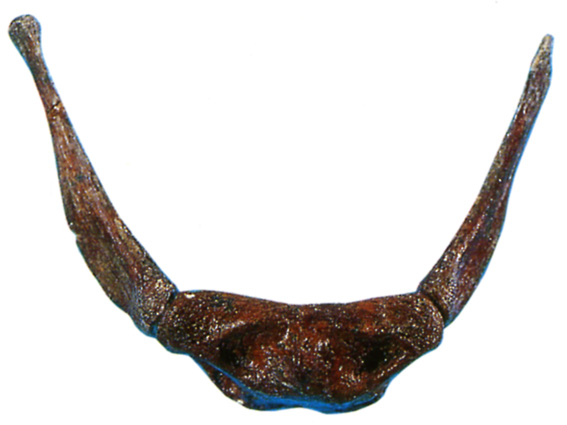 |
Linguistic Capability |  |
 |
Linguistic Capability |  |
![]() In the 1970s, linguist Philip Lieberman and anatomist Edmund Crelin stated
that "Neandertals had a tongue and larynx badly placed for producing the
range of sounds necessary for complex modern language" (Gibbons 1992:33).
This
In the 1970s, linguist Philip Lieberman and anatomist Edmund Crelin stated
that "Neandertals had a tongue and larynx badly placed for producing the
range of sounds necessary for complex modern language" (Gibbons 1992:33).
This  theory was widely believed by many anthropologist until recently, when
a Neandertal skeleton was discovered in the Middle East with a hyoid bone,
or throat bone, that was identical to modern man. However, since this Neandertal's
hyoid and jaw bone were all that was preserved from his face, his vocal
tract could not be reconstructed. Normally, in recreating such an organ,
the skull is needed because impressions are left upon it, which are used
to predict the position of the vocal tract. David Frayer, of the University
of Kansas in Lawrence, believes that Neandertal speech and language ability
was equivalent to modern humans. He compared the bending in the base, or
basicranium, in Neandertal skull and modern human skulls. The four Neandertal
basicraniums used in his study all resembled modern human skulls dating
from 25,000 B.C. to mediaeval times (Bower 1992).
theory was widely believed by many anthropologist until recently, when
a Neandertal skeleton was discovered in the Middle East with a hyoid bone,
or throat bone, that was identical to modern man. However, since this Neandertal's
hyoid and jaw bone were all that was preserved from his face, his vocal
tract could not be reconstructed. Normally, in recreating such an organ,
the skull is needed because impressions are left upon it, which are used
to predict the position of the vocal tract. David Frayer, of the University
of Kansas in Lawrence, believes that Neandertal speech and language ability
was equivalent to modern humans. He compared the bending in the base, or
basicranium, in Neandertal skull and modern human skulls. The four Neandertal
basicraniums used in his study all resembled modern human skulls dating
from 25,000 B.C. to mediaeval times (Bower 1992).
![]() In contrast, Philip Lieberman still believes that Neandertals were incapable
of producing proper unnasalized speech, and could not pronounce such vowels
as a, i, and u, or velar consonants as k and
g,
all of which are almost universal in human speech (Lieberman 1992). He
based his evidence on the fact that Neandertals tongues are largely contained
within the oral cavity, which would have prevented them from accomplishing
the sudden changes in the supra laryngeal airway shape that are necessary
for producing the above consonance and vowels (Lieberman 1992). The nasal
cavities also would not be sealed off from the airway, causing a nasualar
sound when speaking. Due to these functions, Lieberman believes Neandertals
did not posses modern speech.
In contrast, Philip Lieberman still believes that Neandertals were incapable
of producing proper unnasalized speech, and could not pronounce such vowels
as a, i, and u, or velar consonants as k and
g,
all of which are almost universal in human speech (Lieberman 1992). He
based his evidence on the fact that Neandertals tongues are largely contained
within the oral cavity, which would have prevented them from accomplishing
the sudden changes in the supra laryngeal airway shape that are necessary
for producing the above consonance and vowels (Lieberman 1992). The nasal
cavities also would not be sealed off from the airway, causing a nasualar
sound when speaking. Due to these functions, Lieberman believes Neandertals
did not posses modern speech.
![]() Artistic evidence suggest something different. With the recent discovery
of the flute and other artifacts, it has been theorized that Neandertals
must have possessed the ability to verbally communicate. According to Alexander
Marshack, the existing art work holds symbolic factors. It is possible
that Neandertals had to explain these manifestations to their kin groups
with oral words. Also, in studying their form hunting, they must have made
some sort of spoken communication so that they would know which way to
proceed with the hunt.
Artistic evidence suggest something different. With the recent discovery
of the flute and other artifacts, it has been theorized that Neandertals
must have possessed the ability to verbally communicate. According to Alexander
Marshack, the existing art work holds symbolic factors. It is possible
that Neandertals had to explain these manifestations to their kin groups
with oral words. Also, in studying their form hunting, they must have made
some sort of spoken communication so that they would know which way to
proceed with the hunt.
![]()
Links on Neandertal Speech